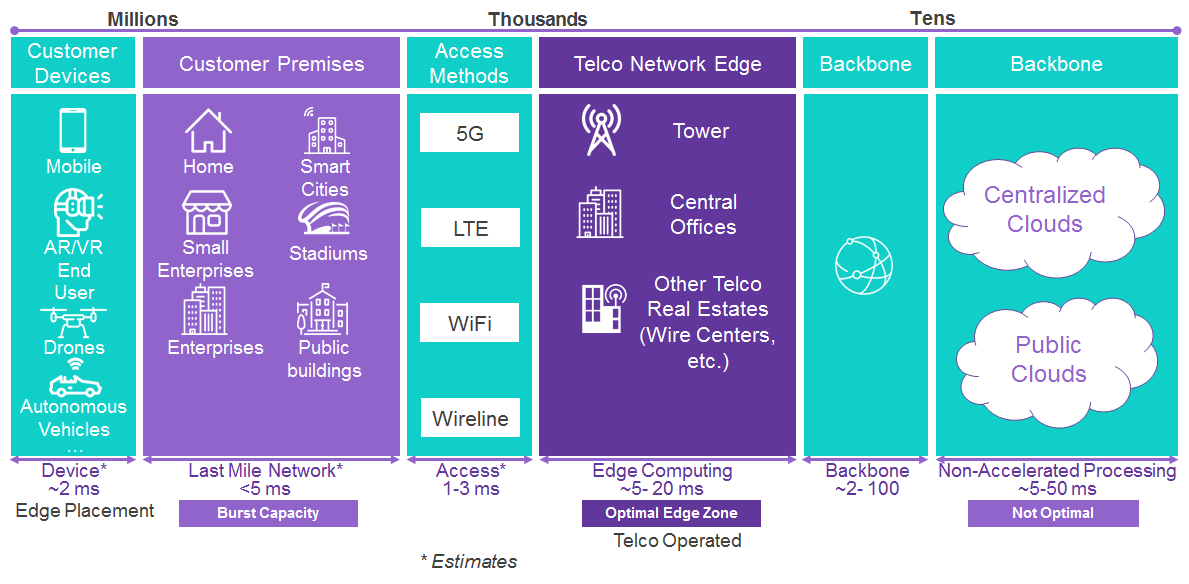...
There are many open source projects that provide component capabilities required for edge computing. However, there is no holistic solution to address the need for fully integrated edge infrastructure.
Akraino Edge Stack, a Linux Foundation project initiated by AT&T and Intel, intend intends to develop a fully integrated edge infrastructure solution, and the project is completely focused towards Edge Computing. This open source software stack provides critical infrastructure to enable high performance, reduce latency, improve availability, lower operational overhead, provide scalability, address security needs, and improve fault management. The Akraino community will address multiple edge use cases and industry, not just Telco Industry. Akraino community intended intends to develop solution and support of carrier, provider, and the IoT networks.
AT&T's seed code will enable carrier-scale edge computing applications to run in virtual machines and containers. AT&T’s contributions, which will include support for 5G, IoT, and other networking edge services will enhance reliability and enable high performance.
Intel upstreamed Wind River Titanium Cloud portfolio of technologies to open source in support of additional blueprints in Akraino.
The Akraino Edge Stack project communityCommunity, while embracing several existing open source projects, will continue the focus on the following Community Goal:
...
- Telco NFV Edge Infrastructure - Running cloud infrastructure at the network edge allows for the virtualization of applications key to running 5G mobility networks at a greater larger scale, density and lower cost using commodity hardware. This In addition this infrastructure can also enables enable the virtualization of wireline services, Enterprise IP services and even supports the virtualization of client premises equipment. This reduces the time to provision new services for customers and even, in some cases, allows those customers to self-provision their service changes.
- Autonomous devices - Drones, Autonomous Vehicles, Industry Robots and such customer devices require a lot of compute processing power in order to support video processing, analytics and etc., Edge computing enables above-said devices to offload the computing processing to the Edge within the needed latency limit.
- Immersive Experiences - Devices like Virtual Reality (VR) headsets and Augmented Reality applications on user’s mobile devices also require extremely low levels of latency to prevent lag that would degrade their user experience. To ensure this experience is optimal, placing computing resources close to the end user to ensure the lowest latencies to and from their devices is critical.
- IoT & Analytics - Emerging technologies in the Internet of Things (IoT) demands lower latencies and accelerated processing at the edge.
...
The processing power demands of customer devices, namely AR/VR, Drones, and Autonomous Vehicles are ever increasing and require very low latency, typically measured in milliseconds. The place where processing takes place plays a major role with respect to quality of user experience and cost of ownership. Centralized cloud decreases the TCO, but fails to address the low latency requirement. Placement at customer premises is nearly impossible with respect to cost and infrastructure. Considering the cost, low latency, and high processing power requirements, the best available option is to utilize the existing infrastructure like Telco’s tower, central offices, and other Telco real estates. These will be the optimal zones for the edge placement.
Akraino
...
The Akraino Edge Stack is a collection of multiple blueprints. Blueprints are the declarative configuration of entire stack i.e., Cloud platform, API, and Applications. Intend Intent of Akraino Edge Stack is to support VM, container and bare metal workloads. Akraino is a complimentary OpenSource project and it is intended to use upstream community work in addition to the software development within the Akraino community.
A typical service provider will have thousands of Edge sites. These Edge sites could be deployed at Cell tower, Central offices, and other service providers real estate such as wire centers. End-to-End Edge automation and Zero-Touch provisioning are required to minimize OPEX and meet the requirements for provisioning agility.
The Akraino Edge Stack is intended to support any type of access methodologies such as Wireless (4G/LTE, 5G), Wireline, Wi-Fi, etc.,
In order to be resilient, Akraino Edge Stack deployment intent to follow the hierarchy of deployments such as collection of central sites that deploys deploy a collection of regional sites. The regional sites that facilitates facilitate the deployment of Edge Sites. For example, the figure below shows the central site C1 and C2 allows the management of regional sites R1, R2, R3, and R4. And regional sites allows the management of Edge Sites which are remote and closer to the users.
...
To promote the high availability of Edge Cloud services, Akraino regional sites are setup set up redundantly to overcome site failures.
